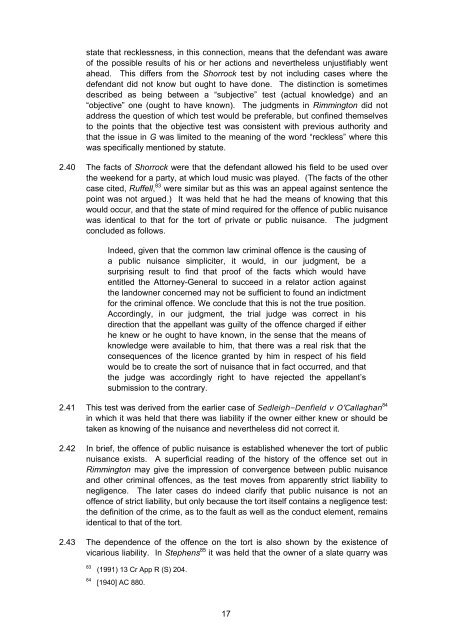public nuisance and outraging public decency - Law Commission
public nuisance and outraging public decency - Law Commission
public nuisance and outraging public decency - Law Commission
Create successful ePaper yourself
Turn your PDF publications into a flip-book with our unique Google optimized e-Paper software.
state that recklessness, in this connection, means that the defendant was aware<br />
of the possible results of his or her actions <strong>and</strong> nevertheless unjustifiably went<br />
ahead. This differs from the Shorrock test by not including cases where the<br />
defendant did not know but ought to have done. The distinction is sometimes<br />
described as being between a “subjective” test (actual knowledge) <strong>and</strong> an<br />
“objective” one (ought to have known). The judgments in Rimmington did not<br />
address the question of which test would be preferable, but confined themselves<br />
to the points that the objective test was consistent with previous authority <strong>and</strong><br />
that the issue in G was limited to the meaning of the word “reckless” where this<br />
was specifically mentioned by statute.<br />
2.40 The facts of Shorrock were that the defendant allowed his field to be used over<br />
the weekend for a party, at which loud music was played. (The facts of the other<br />
case cited, Ruffell, 83 were similar but as this was an appeal against sentence the<br />
point was not argued.) It was held that he had the means of knowing that this<br />
would occur, <strong>and</strong> that the state of mind required for the offence of <strong>public</strong> <strong>nuisance</strong><br />
was identical to that for the tort of private or <strong>public</strong> <strong>nuisance</strong>. The judgment<br />
concluded as follows.<br />
Indeed, given that the common law criminal offence is the causing of<br />
a <strong>public</strong> <strong>nuisance</strong> simpliciter, it would, in our judgment, be a<br />
surprising result to find that proof of the facts which would have<br />
entitled the Attorney-General to succeed in a relator action against<br />
the l<strong>and</strong>owner concerned may not be sufficient to found an indictment<br />
for the criminal offence. We conclude that this is not the true position.<br />
Accordingly, in our judgment, the trial judge was correct in his<br />
direction that the appellant was guilty of the offence charged if either<br />
he knew or he ought to have known, in the sense that the means of<br />
knowledge were available to him, that there was a real risk that the<br />
consequences of the licence granted by him in respect of his field<br />
would be to create the sort of <strong>nuisance</strong> that in fact occurred, <strong>and</strong> that<br />
the judge was accordingly right to have rejected the appellant’s<br />
submission to the contrary.<br />
2.41 This test was derived from the earlier case of Sedleigh–Denfield v O’Callaghan 84<br />
in which it was held that there was liability if the owner either knew or should be<br />
taken as knowing of the <strong>nuisance</strong> <strong>and</strong> nevertheless did not correct it.<br />
2.42 In brief, the offence of <strong>public</strong> <strong>nuisance</strong> is established whenever the tort of <strong>public</strong><br />
<strong>nuisance</strong> exists. A superficial reading of the history of the offence set out in<br />
Rimmington may give the impression of convergence between <strong>public</strong> <strong>nuisance</strong><br />
<strong>and</strong> other criminal offences, as the test moves from apparently strict liability to<br />
negligence. The later cases do indeed clarify that <strong>public</strong> <strong>nuisance</strong> is not an<br />
offence of strict liability, but only because the tort itself contains a negligence test:<br />
the definition of the crime, as to the fault as well as the conduct element, remains<br />
identical to that of the tort.<br />
2.43 The dependence of the offence on the tort is also shown by the existence of<br />
vicarious liability. In Stephens 85 it was held that the owner of a slate quarry was<br />
83 (1991) 13 Cr App R (S) 204.<br />
84 [1940] AC 880.<br />
17

















